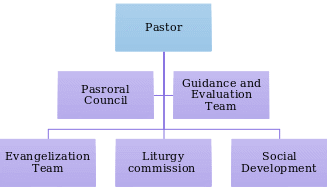Organizational Chart: The Redeemed Christian Church of God
Understanding the inherent logic within the church structure is essential for the future development, leadership, and management of a team within a religious context. Though every church is unique and, thus, embodies a unique approach to managing internal processes within its confinements, taking a specific church’s organizational structure as an example provides a handy tool for further similar assessments.
Though the Redeemed Christian Church of God analyzed in this essay has a rather generic organizational structure, it can still boast impressive flexibility since it demonstrates the presence of a Situational Leadership approach applied in the organizational context and the focus on the democratic management style.

Areas of Strength
As the chart above shows, the structure of the Redeemed Christian Church of God is quite essential. Namely, it features the Pastor, who dominates the organization and makes core decisions, assigning roles and responsibilities to his key assistants and defining the core values, standards, and directions for future development. However, while the Pastor maintains the key power position within the Redeemed Christian Church of God, further delegation of responsibilities becomes possible due to the unique principles underlying the leadership framework.
Specifically, with the emphasis on Servant Leadership and the resulting promotion of the freedom of choice for the key stakeholders, the Redeemed Christian Church of God introduces opportunities for a situational approach and options for shared decision-making within the organizational context. The specified outcome leads to an increased improvement in managing key organizational tasks, primarily the allocation of the available resources.
Furthermore, as the chart indicates, the Pastoral Council and the Evaluation Team represent the key sources of assistance for the Pastor. The specified approach to delegating responsibilities within the church contributes to the proper management of core administrative issues. Specifically, the specified teams remain aware of the essential issues within the church, effectively serving as a combination of the executive service and the line managers directing information from the rest of the staff to the Pastor.
In turn, the presence of the Liturgy Commission and the Evaluation Team ensures that the resources required for the core processes within the organization are readily available. Furthermore, the Evaluation Team promotes active development of the relevant knowledge and skills in the parish members, particularly in the younger demographic, which helps uphold core community values and ensure that the parish members align with these values and standards.
Finally, the presence of the Social Development Team contributes to building extensive social connections with key secular organizations within the selected community. The described function is also instrumental to the successful performance of the Redeemed Christian Church of God since it helps reinforce its influence in the target setting. Specifically, the presence of social connections enhances the church’s ability to promote its values and encourage others to accept the essential Christian ideas, therefore becoming its members.
Areas in Need of Improvement, including Proposed Improvements
However, some of the aspects of the current approach to the church’s organization could use certain improvements. Specifically, the lack of a cohesive framework for maintaining communication with the community should be mentioned. Specifically, without the awareness regarding changes and trends within the target community, the church will be unable to address the parish members’ needs. Therefore, the introduction of a team that could serve as intermediaries between the church and the community should be considered a possible solution.
Despite the organizational structure of the Redeemed Christian Church of God is quite generalized, the strategy for addressing organizational issues and the choice of the leadership approach allow for the most effective use of resources and the most sensible strategy for decision-making.
Namely, the focus on providing flexibility in the organizational context while keeping in mind the importance of adhering to the established hierarchy has created premises for the use of the Situational approach to leadership, therefore encouraging staff members to participate in decision-making and accept the role of leaders. Encouraging the development of shared responsibility, the described structure contributes to active development and encourages personal, professional, and spiritual growth among all parties involved.
Bibliography
Awuku-Gyampoh, Ransford Kwabena, and Andy Ohemeng Asare. “Assessing the Impact of Good Governance, Church Management and Structure on the Growth and Development of the Church.” International Journal of Business and Management 14, no. 4 (2019): 99.
Brand, Chad Owen, and Stanton Norman. Perspectives on Church Government: Five Views of Church Polity. Broadman & Holman Publishers: 2004.
Louw, Eric. ‘A Review of the Historical Roots of the Union Conference Organizational Structure in the Seventh-day Adventist Church and Inter-Structural Accountability.’ Andrews University Seminary Student Journal 4, no. 1 (2020): 6.
Mufron, Ali, et al. “Optimizing the Organizational Structure in Transforming Human Resources Who Can Manage Work Stress with a Religious Culture.” European Journal of Molecular & Clinical Medicine 8, no. 3 (2021): 1110-1126.